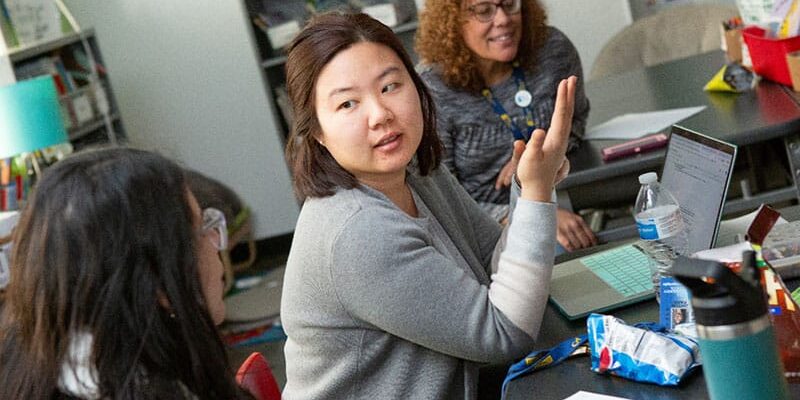Written by Toni Smith, Kirk Walters, Jennifer Zoltners Sherer, and Jennifer Lin Russell.
Photo by Allison Shelley for EDUimages
Improvement Science as a Powerful Tool for Improving Classroom Instruction
In 2015 the Nellie Mae Education Foundation began funding two substantial projects focused on classroom teachers as leaders to support student-centered teaching and learning in New England high schools. Both multi-year projects were organized as Networked Improvement Communities (NICs), an approach in which practitioners worked collaboratively with researchers to use principles of improvement science to quickly test and refine promising instructional strategies and share learnings with one another. Over time, network members shared their work more broadly, spreading the newly refined instructional strategies into their local contexts.
The projects—which had high levels of participation and benefited from the support of a developmental evaluator—demonstrated that NICs are a viable approach to instructional improvement. The Better Math Teaching Network (BMTN) used student-centered instruction to support deep engagement with high school math content, while the Student-Centered Assessment Network (SCAN) engaged high school teachers and students in formative assessment. After five years of this work, researchers leading the projects and developmental evaluators found that:
- Networks of teachers use inquiry cycles and collaborative structures to continuously improve instruction.
- Teachers shifted to more student-centered teaching practices.
- High school students were more engaged.
While Nellie Mae’s strategy is now more specifically focused on “challenging racial inequities and advancing excellent, student-centered public education”, these projects demonstrate promising strategies for supporting teachers to act as leaders and change agents in their schools.
Both projects produced several types of products that new or existing improvement networks may find useful, including:
- Annual summative and developmental evaluation reports that provide a comprehensive picture of each network’s activities in a given year and could be useful for network leaders, funders, and evaluators. This includes reports on the Better Math Teaching Network (BMTN):
…and on the Student-Centered Assessment Network (SCAN):
- Multimedia resources, including a new podcast that describes why this work was valuable and unique to math teachers and students–Better Math Teaching Network Podcast–and a video story of SCAN.
- Instructional routines and professional learning tools for teachers that support student-centered math learning–BMTN: Try a Teaching Strategy–and student-centered assessment–SCAN: Tools & Guides.
- Reports on how teachers spread and sustained their learning in their schools and districts: Beyond the Networked Improvement Community: Designing PLCs to Spread Learning from the Better Math Teaching Network.
- A working paper on how the participation of educators in NICs unfolds over multiple years: Teacher Participation in an Improvement Network: A Working Paper on Developmental Trajectories.
For additional questions on any of these products, contact Toni Smith (tsmith@air.org), Kirk Walters (kwalters@wested.org), Jennifer Zoltners Sherer (jzsherer@pitt.edu) or Jennifer Lin Russell (jennifer.russell@vanderbilt.edu).

